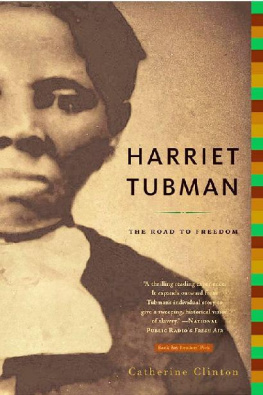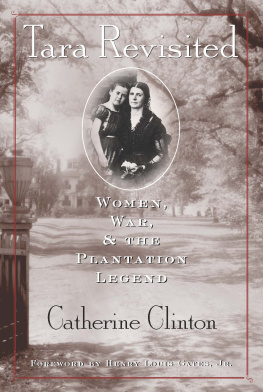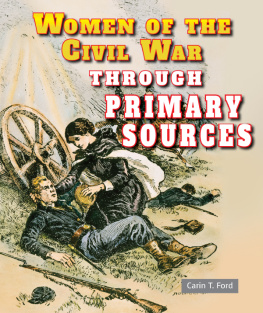Published with the assistance of the V. Ray Cardozier Fund
Published by Louisiana State University Press
Copyright 2016 by Louisiana State University Press
All rights reserved
Manufactured in the United States of America
First printing
Designer: Barbara Neely Bourgoyne
Typefaces: Chaparral Pro and Brix Slab
Printer and binder: McNaughton & Gunn, Inc.
LIBRARY OF CONGRESS CATALOGING-IN-PUBLICATION DATA
Names: Clinton, Catherine, 1952 author.
Title: Stepdaughters of history : southern women and the American Civil War / Catherine Clinton.
Description: Baton Rouge : LSU Press, 2016. | Series: Walter Lynwood Fleming lectures in southern history | Published with the assistance of the V. Ray Cardozier Fund. | Includes bibliographical references and index.
Identifiers: LCCN 2016012821| ISBN 9780807164570 (cloth : alk. paper) | ISBN 9780807164587 (pdf) | ISBN 9780807164594 (epub) | ISBN 9780807164600 (mobi)
Subjects: LCSH: United StatesHistoryCivil War, 18611865Women. | United StatesHistoryCivil War, 1861-1865Participation, Female | WomenSouthern StatesHistory19th century. | United StatesHistoryCivil War, 18611865Social aspects. | Confederate States of AmericaSocial conditions.
Classification: LCC E628 .C575 2016 | DDC 973.7082dc23
LC record available at http://lccn.loc.gov/2016012821
The paper in this book meets the guidelines for permanence and durability of the Committee on Production Guidelines for Book Longevity of the Council on Library Resources.

PREFACE

One Thousand, Four Hundred, and Fifty-Eight Days
The hard hand of war thrashed its way through the grass, uprooting traditions and leaving a trail of bruised refugees and all that remained to a scattering wind. Scared combatants foraged an unfamiliar landscape, trampling flora and fauna, disturbing any natural rhythms, as all lay bare along the banks of memory: fearful of crossing to the other sidethe unknownto perhaps defeat, and to, God forbid, retribution.
The formerly proud nation was laid low, littered with the debris of reckless ego and martial pride. The Confederate nation flourished longer in commemoration than its bleak survival of four memorable, martyred years, from secession in Charleston, from valleys to little round tops, into craters and trenches, from puddles of blood and to oceans of mudspiraling toward the bleak, blank surrender at Appomattox: one thousand, four hundred, and fifty eight days, but whos counting?
Whos counting on those men who went off to protect women and children from insult, then invaders? Whos counting the months and weeks and days when those left behind mopped brows, rolled bandages, darned socks, stitched sashes, and waved handkerchiefs before resorting to using them. After the years rolled by, many began to chronicle poignant accounts of countless sacrifices and the inglorious deeds of the enemy. The writing was therapy, but the rereading could not provide cure.
And when the snakes were driven out at last, when the disbanded soldiers gave up to traipse their homeward trek, it was not an afterthought. The aftermath raised more uncomfortable truths for those who did not want to let the facts get in the way of their stories. Stories would redefine the contest for this generation, and the next, and the next after thata rope of sand and sentiment.
Broken men returned home to a place where they had once turned over rich fertile sod, raising crops the world eagerly soughttobacco, sugar, rice, indigo, and the mightiest of them all, King Cotton. The ships had come in, the coffers filled as planters bought, sold, shifted, and carved their claims into a sparsely settled land. As the coffers filled, the coffles filed; land-hungry settlers zigzagged the continent. Europeans imported enslaved Africans to resupply the swept acres with laborers, putting them to backbreaking work on land stripped of its native inhabitantsresourceful enough most often to escape enslavement, but not able to stave off disease and subsequent decline.
The cost to two continents was unfathomable, when people on islands and peninsulas pushed, prodded, and pummeled their way toward inheriting the earth. From sea to shining sea, prairie schooners blossomed between two oceans. Crashing up against the elements, crushing obstacles to expansionism, the settlers embarked on a stampede of greed. Supplying ports across the globe with luxury goods and necessities, these visionary, predatory settlers sprinkled mercantilism and misery along their path, while always trying to remember the best way home.
Even if it was not their hands getting dirty, and dirtier still, it was still their dirt. They possessed the birthright, willpower, and hubris to dictate termshow dare anything interfere with their destiny to conquer? They could redact representation with barely a glance backward at their own pasts, because retrospect was focused tightly on the glories of ancient Romereplete with bowing Catos and scraping Pompeys. All deference due to the patriarch, as underlings might hang onto every word as gospel, mistaking whims for wisdom, a purposeful pretense. The show was meant to mask fears of incursions from intrusive reality.
Who could not be sad to see such fertile crescents strewn with corpses? Why should these beautiful lands have become so scarred? What had led to this disjuncture, to this brawling, sprawling blight upon the land? Was it just in mans nature? Was it always man versus nature? Because of the natural divides, not just the alleged abyss between black and white, free and slave, but additionally that most fundamental reckoning between men and women?
Women, ah women, suffered through perpetual pregnancies and multiple births, clinging for dear life to families they had to produce as the men continued their relentless charge into the wilderness, cropping and taming at every turn. Black families were savagely uprooted, with a million displaced and enchained during the decades leading up to the war.
And when the war came, white southern women were urged to pray for victory, to remain stoic in the face of blockades, abandonment, invasions, and the irregular posting of death lists. Females young and old, staring down the long barrel of life, hoping to stave off the worst of what they feared might come, as men marched off, even sallied forth. Between three and four hundred thousand of those men

















